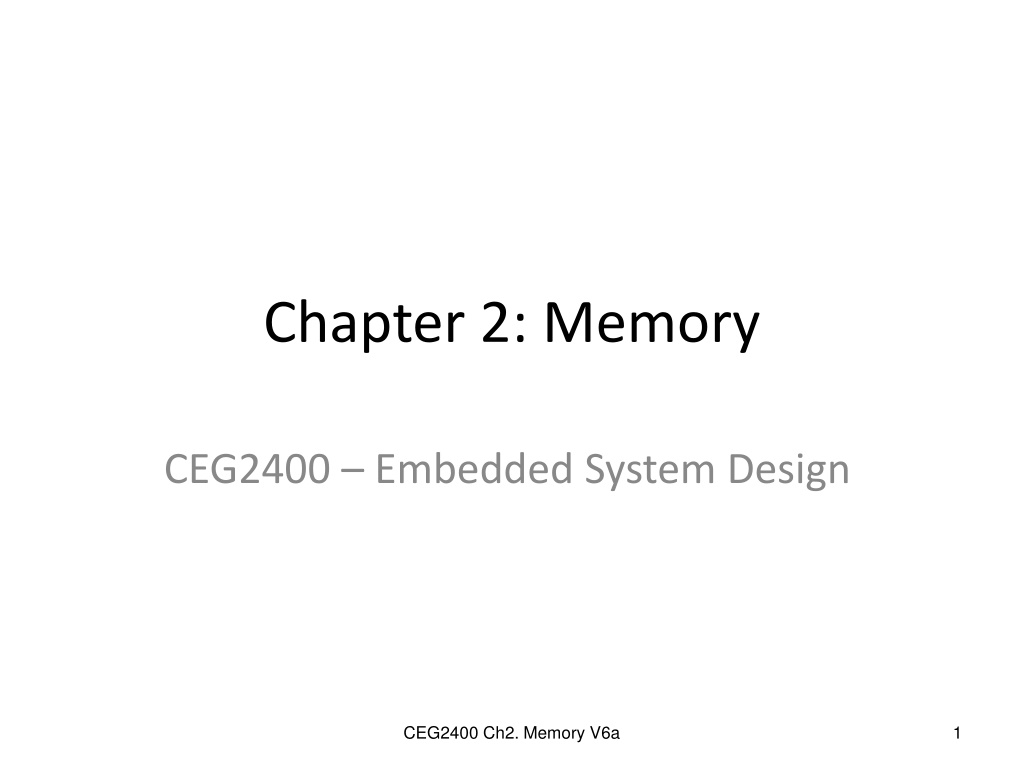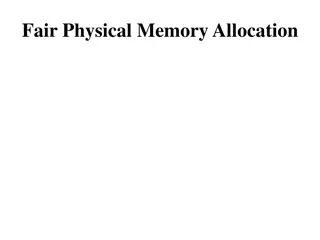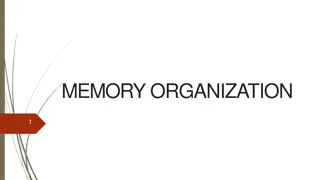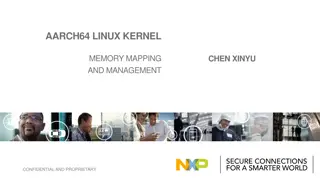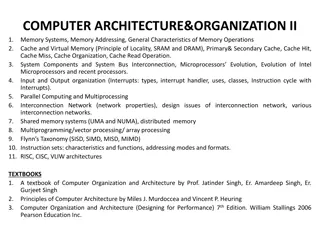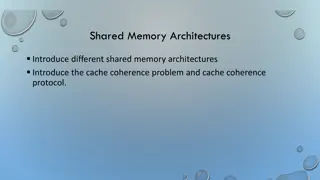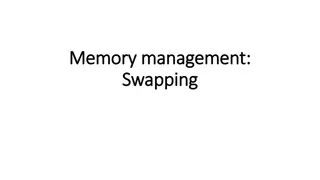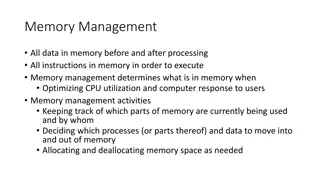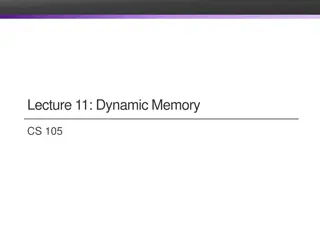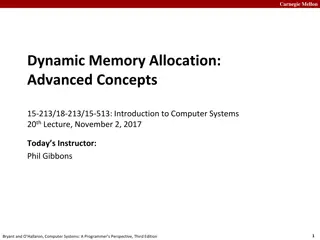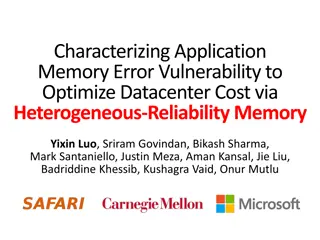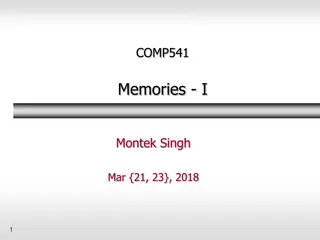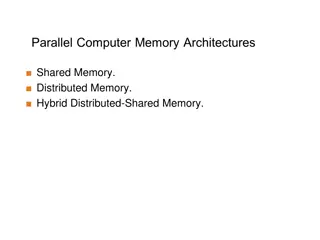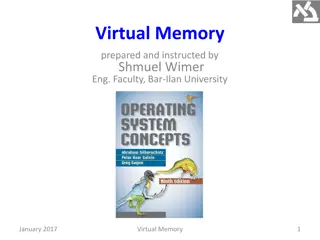Computer Memory Types
This chapter delves into the intricacies of memory in computer systems, exploring different types of memory, concepts of address, data, and program execution. Learn about the components inside a computer, ARM microcontrollers, and the role of CPU and MCU as microprocessors. Discover the various memory types like RAM and ROM, their characteristics, and usage in embedded systems. Uncover the distinctions between SRAM and DRAM, highlighting their strengths and weaknesses for primary memory applications.
Download Presentation

Please find below an Image/Link to download the presentation.
The content on the website is provided AS IS for your information and personal use only. It may not be sold, licensed, or shared on other websites without obtaining consent from the author.If you encounter any issues during the download, it is possible that the publisher has removed the file from their server.
You are allowed to download the files provided on this website for personal or commercial use, subject to the condition that they are used lawfully. All files are the property of their respective owners.
The content on the website is provided AS IS for your information and personal use only. It may not be sold, licensed, or shared on other websites without obtaining consent from the author.
E N D
Presentation Transcript
Chapter 2: Memory CEG2400 Embedded System Design CEG2400 Ch2. Memory V6a 1
Overview 1) Memory in a computer system 2) Different memory types 3) Concepts of address, data and program running CEG2400 Ch2. Memory V6a 2
1) Memory in a computer system A computer has CPU (Central Processing Unit) Memory Input/output and peripheral devices Glue logic circuits CEG2400 Ch2. Memory V6a 3
Inside an ARM microcontroller Inside ARM CPU: Central Processing unit Clock Oscillator memory Peripheral devices: serial, parallel interfaces; real-time-clock etc. Peripheral devices: USB, serial, parallel bus etc. CEG2400 Ch2. Memory V6a 4
A computer with a micro-controller unit External interfacing MCU: CPU: Central Process- ing unit memory actuators : such as Motors, Heaters, speakers Periphera l IO interface devices: such as USB bus, parallel bus, RS232 etc. Keyboard mouse Peripheral devices: USB ports, Graphic card, real-time-clock etc. Sensors: Light, Temperature Etc. CEG2400 Ch2. Memory V6a 5
CPU, MCU are microprocessors CPU: Central Processing unit Requires memory and input output system to become a computer (e.g. Pentium is a CPU). MCU: micro-controller unit (or single chip computer) Contains memory, input output systems, can work independently (e.g. Arm7, 8051 are MCUs). Used in embedded systems such as washing machines, mobile phones/pads. CEG2400 Ch2. Memory V6a 6
2) Different memory types Random access memory (RAM) Read only memory (ROM) CEG2400 Ch2. Memory V6a 7
Different kinds of Random access Memory (RAM) Random access memory (RAM): data will disappear after power down. Static RAM (SRAM): each bit is a flip-flop, fast but expensive. Dynamic RAM (DRAM): each bit is a small capacitor, and is needed to be recharged regularly; slower but cheap. To be used as primary memory in a computer. http://thalia.spec.gmu.edu/~pparis/classes/notes_101/img111.gif http://www.prontotech.com/product/kingston-8gb-dram-memory-module-p_1732875237 CEG2400 Ch2. Memory V6a 8
Different kinds of Read Only Memory (ROM) Read only memory (ROM) UV-EPROM EEPROM FLASH ROM CEG2400 Ch2. Memory V6a 9
UV-EPROM Data can be erased by putting it under strong Ultra-Violet (UV) light for 1/2 hours. CEG2400 Ch2. Memory V6a 10
Flash memory Block based read/write, e.g. one block can be 512 or 1024 bytes, etc. Read/write is slower than DRAM, so it cannot be used as the primary memory of a computer. www.sandisk.com CEG2400 Ch2. Memory V6a 11
Exercise 0 What are these memory types: (DRAM, SRAM, ROM) in a computer? Explain why. Central Processing Unit Registers Primary memory for storing program and data: memory type=______? CPU Registers: memory type = _______? Firmware (basic input/output system or BIOS ) memory type=___________? CEG2400 Ch2. Memory V6a 12
3) Concepts of address, data and program running Address-- tells you where to find the storage. Data-- is the content stored in the address. CEG2400 Ch2. Memory V6a 13
Binary 0000 0001 0010 0011 0100 0101 0110 0111 1000 1001 1010 1011 1100 1101 1110 1111 Decimal 0 1 2 3 4 5 6 7 8 9 10 11 12 13 14 15 Hex 0 1 2 3 4 5 6 7 8 9 A B C D E F Exercise 1: Binary number and hex number A binary number can be 1 or 0 4 binary numbers make up a hexadecimal (hex) number (0- >F) Exercise1 Convert 3AH into binary . Convert a binary number 100001011100B into hex and decimal. CEG2400 Ch2. Memory V6a 14
Memory is like a tall building Address cannot change; content (data) can change Address content, e.g. A 64K-byte RAM 16-bit Address (H=Hex) FFFF H 35H FFFE H 23H 0ACD H 24H 0001 H 32H 0000 H 2BH 8-bit content (data) CEG2400 Ch2. Memory V6a 15
Memory for storing program and data (An 8-bit machine) 16-bit Address (H=Hex) FFFF H FFFE H 0ACD H 8-bit content (program /data) 35H 23H 24H (do something) 32H 2BH (goto 0ACDH) Basic concept Memory is like a tall building Address cannot change; content (data) can change 0001 H 0000 H After power up , goto 0000H , run instructions in data CEG2400 Ch2. Memory V6a 16
Two important modules in a 8-bit CPU (because data is 8-bit, e.g. Intel 8051): Program counter and registers A Central Processing Unit (CPU) has PC : program counter to keep track the program R0, R1, etc, for general purpose usage An 8-bit CPU (Intel 8051) Registers (8 bits): PC: program counter Memory (data is 8-bit) R0 (general purpose) R1 (general purpose) CEG2400 Ch2. Memory V6a 17
Program counter (PC) After CPU reset (power up) , PC=0000H, so the first instruction is always at 0000H. After each instruction is run, PC increments once, or PC is set by the instruction it just executed. E.g. goto to a new address. CEG2400 Ch2. Memory V6a 18
How does a computer work? What is the content of Program counter (PC) after each step? 16-bit Address (H=Hex) FFFF H FFFE H 0ACD H 8-bit content (data) 35 23 24 (goto FFFF) 32 2B (goto0ACD) Program is in memory Inside an 8-bit Central Process.Unit Program counter (16 bits): PC xxxxH step3 General purpose registers ( 8bits): R0=xxH R1=yyH etc. 0001 H 0000 H step2 After power up PC=0000H step1 CEG2400 Ch2. Memory V6a 19
Exercise2 : A simple program , fill in ? After power up, the first instruction is in 0000H, PC=0000H Address (H=Hex) 8-bit content (data)=instructions (Hex) PC before Running the instruction (hex) ? PC after Running the instruction (hex) ? 0BC8 Instruction k = 25: (meaning R0<=R0+1) Instruction j = 24 (meaning :goto 0BC8) Instruction 2=xx Instruction1=2B (meaning : goto 0AC0H) 0AC1 0AC0 ? ? 0001 0000 ? ? CEG2400 Ch2. Memory V6a 20
Exercise 3: Program to find 2+3=?, Fill in ? PC=program counter; R0=general purpose register 0 Address (H=Hex) 8-bit content (data) The machine code is make up for this example Before the instruction is run After the instruction is run PC R0 PC R0 0F00 What is the Content after the program is run? 0AD3 3F=stop 0AD3 ? ? ? 0AD2 C0=Save R0 into address location 0F00 and clear R0 0AD2 ? ? ? 0AD1 2E=Add 2 to Reg .R0 0AD1 ? ? ? 0AD0 15=Move 3 into Reg. R0 0AD0 ? ? ? 0001 0000 2B=Goto address 0AD0 0000 0 (after reset) ? ? CEG2400 Ch2. Memory V6a 21
Memory in a 32-bit machine Moving from 8-bit to 32-bit: The ARM processor example CEG2400 Ch2. Memory V6a 22
ARM chip CEG2400 Ch2. Memory V6a 23
Memory We will learn how to use memory in the ARM microcontroller. We know that the data size is 8-bit for all memory systems (in PC or mainframe alike). So each location has 8 bits. We can deal with them in n-bit groups called words (typically 8, 16, 32 or 64 bits) CEG2400 Ch2. Memory V6a 24
Address in a 32-bit machine (e.g. ARM7) The address is 32-bit. So the address range is from 0000 0000(hex) to FFFF FFFF(hex) totally 2^32=4G locations. The data is also 32-bit. So each data is xxxx xxxx (hex) But the memory is arranged as 8-bit for one location. So how to do it? Solution: Arm7 uses 4 address locations to access a 32- bit (4 bytes) data. CEG2400 Ch2. Memory V6a 25
Rules/Examples Address data Each location must be 8-bit. For a 32-bit word, you are referring to 4 locations. 0000 0003H A 16-bit word (0000 0002- > 0000 0003H) 0000 0002H 32-bit Word (0000 000 -> 0000 0003H) 0000 0001H One byte At 0000 0001H 0000 0000H One byte at 0000 0000H CEG2400 Ch2. Memory V6a 26
Organization of memory in ARM n=32bits (4 bytes) Address 0xFFFF FFFC 0xFFFF FFF8 last 32-bit word ith word 0x0000 0010 0x0000 000C 0x0000 0008 0x0000 0004 0x0000 0000 second 32-bit word 1Byte 1 Byte 1 Byte 1 Byte First 32-bit word n=32bits (4 bytes) Address is incremented by 4 CEG2400 Ch2. Memory V6a 27
Compare 8-bit (e.g.8051) and 32- bit (Arm7) machines examples A 32-bit machine program (e.g. ARM) An 8-bit machine program (e.g. 8051) Address (H=Hex) Address (H=Hex) 1E00 0ADC 1E00 0AD8 1E00 0AD4 1E00 0AD0 : 0000 0008 0000 0004 0000 0000 Address is incremented by 4 Each data is 32-bit (4 bytes) 1123 556D 0012 2A3F 2134 5678 3A11 89A1 Each data is 8-bit (1 byte) 13 : 21 22 89 4A 2D 0F00 : 0AD2 0AD1 0AD0 0001 0000 Address is incremented by 1 1122 3344 9870 A178 0000 002A CEG2400 Ch2. Memory V6a 28
Integers and Characters 32 bits b31b30 b1 b0 for positive numbers for negative numbers Sign bit: b31 b31 = = 0 1 (a) A signed integer 8 bits 8 bits 8 bits 8 bits ASCII ASCII ASCII ASCII character character character character (b) Four characters CEG2400 Ch2. Memory V6a 29
Exercise 4: More/less significant bytes Consider the hexadecimal (base 16) 32-bit number 12342A3F(H)=1x167+2x166+3x165+4x164+2x163+10x162+3x161+15x160 This number has four bytes 12, 34, 2A, 3F (4x8=32-bits) Bytes/bits with higher weighting are more significant e.g. the byte 34 is more significant than 2A Bytes/bits with lower weighting are less significant We also use terms most significant byte/bit and least significant byte/bit Excise4: For 12342A3F(H) Write the binary number. What is the most significant byte/bit? What is the least significant byte/bit? CEG2400 Ch2. Memory V6a 30
Big/little endian Two different ways: byte addresses are assigned across words more significant bytes first (big endian) less significant bytes first (little endian) ARM allows both big and little endian addresses LPC2100 allows big and small endians CEG2400 Ch2. Memory V6a 31
Examples From http://en.wikipedia.org/wiki/Endianness more significant bytes first (big endian) less significant bytes first (little endian) Most significant least significant CEG2400 Ch2. Memory V6a 32
Exercise 5, fill in ? Save 0x2EAB057E in memory starting from 0x4000 Address (data in each address location must be 8-bit) 0x4000 0x4001 0x4002 0x4003 Little endian data Big endian data 7E ? ? ? ? ? ? 7E CEG2400 Ch2. Memory V6a 33
Word alignment 32-bit words align naturally at addresses 0, 4, 8 These are aligned addresses Unaligned accesses are either not allowed or slower e.g. read a 32-bit word from address 1 (why?) E.g 0x2EAB057E from 0x4000 is aligned E.g 0x2EAB057E from 0x4001 is misaligned In ARM A word = 32-bits, half-word = 16 bits Words aligned on 4-byte boundaries i.e. word addresses must be multiples of 4 Half words aligned on even byte boundaries CEG2400 Ch2. Memory V6a 34
Example of word alignment 32-bit words align naturally at addresses 0, 4, 8..etc That means a (address)= 0,4,8, or a(address)=4N where N=integer a is a multiple of N CEG2400 Ch2. Memory V6a 35
End CEG2400 Ch2. Memory V6a 36
References/ reading exercise http://www.howstuffworks.com/computer- memory.htm ARM versus Intel: a successful stratagem for RISC or grist for CISC's tricks? http://www.edn.com/design/integrated-circuit-design/4369610/ARM-versus- Intel-a-successful-stratagem-for-RISC-or-grist-for-CISC-s-tricks- CEG2400 Ch2. Memory V6a 37
